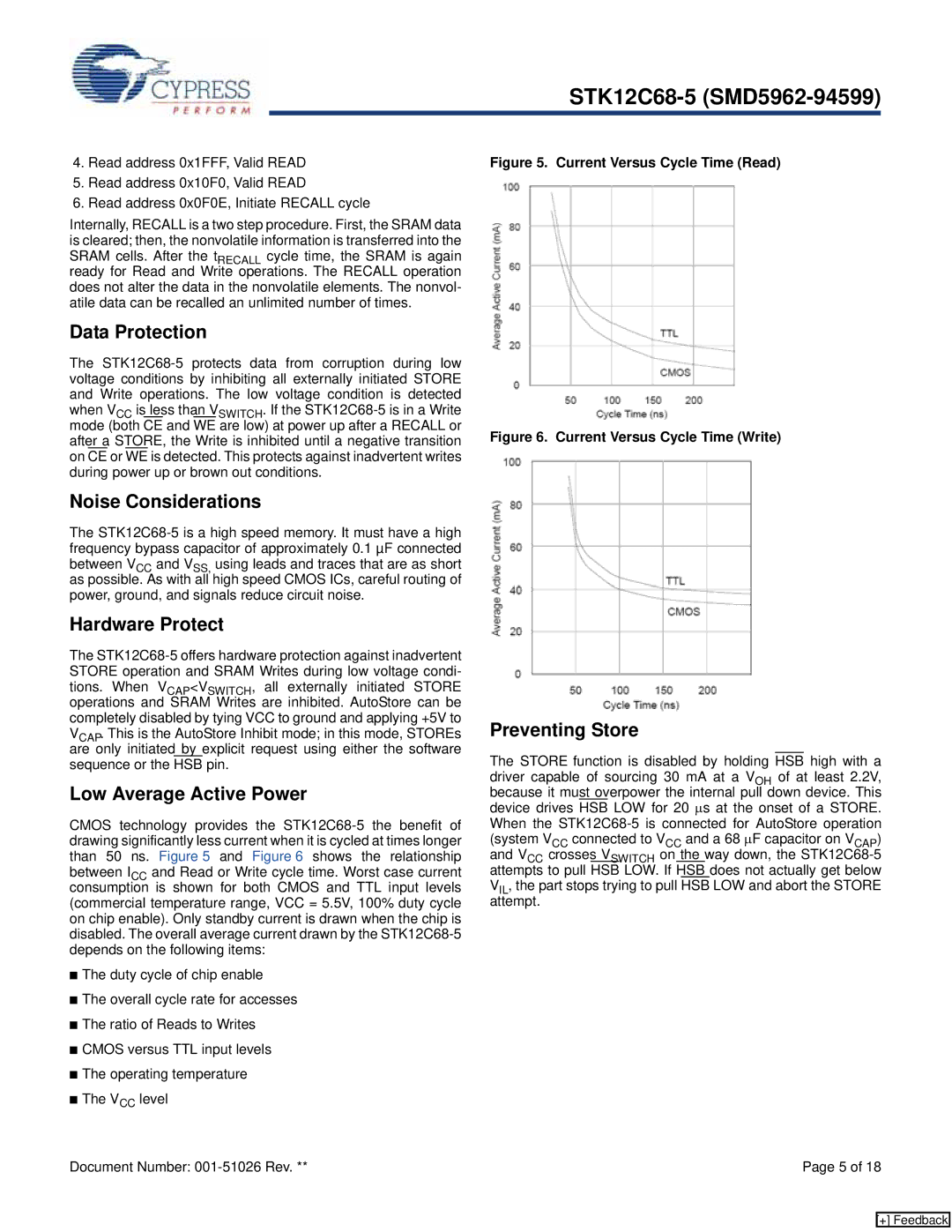4.Read address 0x1FFF, Valid READ
5.Read address 0x10F0, Valid READ
6.Read address 0x0F0E, Initiate RECALL cycle
Internally, RECALL is a two step procedure. First, the SRAM data is cleared; then, the nonvolatile information is transferred into the SRAM cells. After the tRECALL cycle time, the SRAM is again ready for Read and Write operations. The RECALL operation does not alter the data in the nonvolatile elements. The nonvol- atile data can be recalled an unlimited number of times.
Data Protection
The STK12C68-5 protects data from corruption during low voltage conditions by inhibiting all externally initiated STORE and Write operations. The low voltage condition is detected when VCC is less than VSWITCH. If the STK12C68-5 is in a Write mode (both CE and WE are low) at power up after a RECALL or after a STORE, the Write is inhibited until a negative transition on CE or WE is detected. This protects against inadvertent writes during power up or brown out conditions.
Noise Considerations
The STK12C68-5 is a high speed memory. It must have a high frequency bypass capacitor of approximately 0.1 µF connected between VCC and VSS, using leads and traces that are as short as possible. As with all high speed CMOS ICs, careful routing of power, ground, and signals reduce circuit noise.
Hardware Protect
The STK12C68-5 offers hardware protection against inadvertent STORE operation and SRAM Writes during low voltage condi- tions. When VCAP<VSWITCH, all externally initiated STORE operations and SRAM Writes are inhibited. AutoStore can be completely disabled by tying VCC to ground and applying +5V to VCAP. This is the AutoStore Inhibit mode; in this mode, STOREs are only initiated by explicit request using either the software sequence or the HSB pin.
Low Average Active Power
CMOS technology provides the STK12C68-5 the benefit of drawing significantly less current when it is cycled at times longer than 50 ns. Figure 5 and Figure 6 shows the relationship between ICC and Read or Write cycle time. Worst case current consumption is shown for both CMOS and TTL input levels (commercial temperature range, VCC = 5.5V, 100% duty cycle on chip enable). Only standby current is drawn when the chip is disabled. The overall average current drawn by the STK12C68-5 depends on the following items:
■The duty cycle of chip enable
■The overall cycle rate for accesses
■The ratio of Reads to Writes
■CMOS versus TTL input levels
■The operating temperature
■The VCC level
Figure 5. Current Versus Cycle Time (Read)
Figure 6. Current Versus Cycle Time (Write)
Preventing Store
The STORE function is disabled by holding HSB high with a driver capable of sourcing 30 mA at a VOH of at least 2.2V, because it must overpower the internal pull down device. This device drives HSB LOW for 20 μs at the onset of a STORE. When the STK12C68-5 is connected for AutoStore operation (system VCC connected to VCC and a 68 μF capacitor on VCAP) and VCC crosses VSWITCH on the way down, the STK12C68-5 attempts to pull HSB LOW. If HSB does not actually get below VIL, the part stops trying to pull HSB LOW and abort the STORE attempt.

